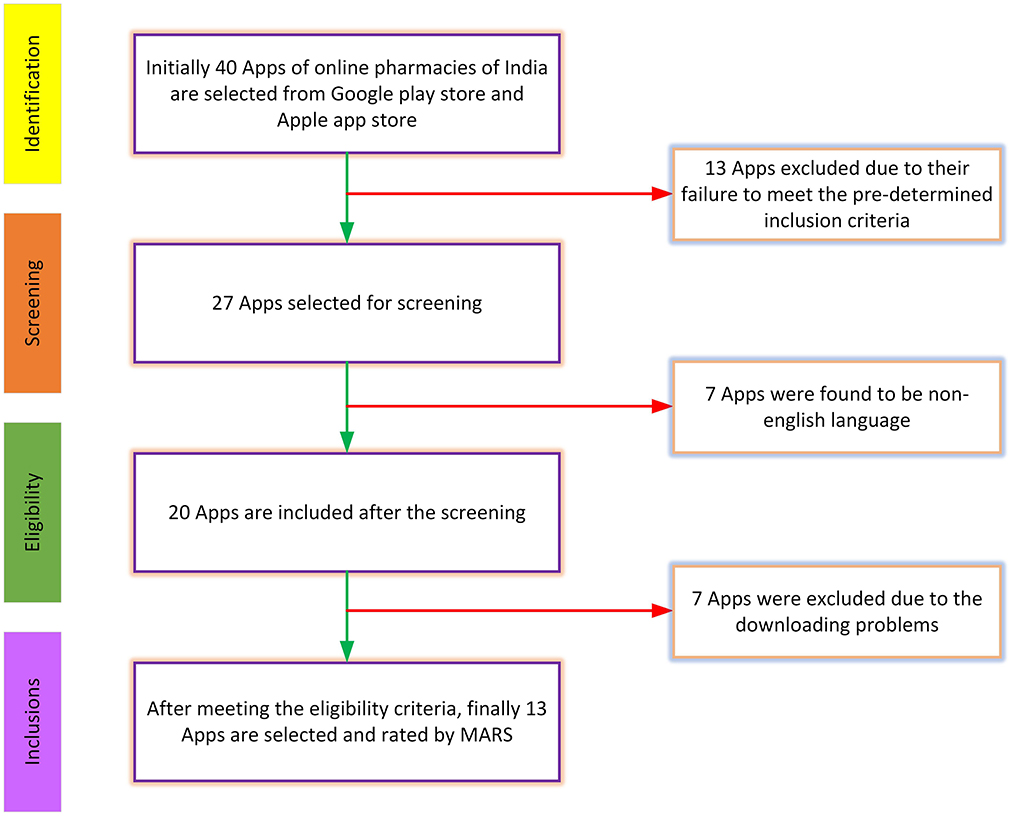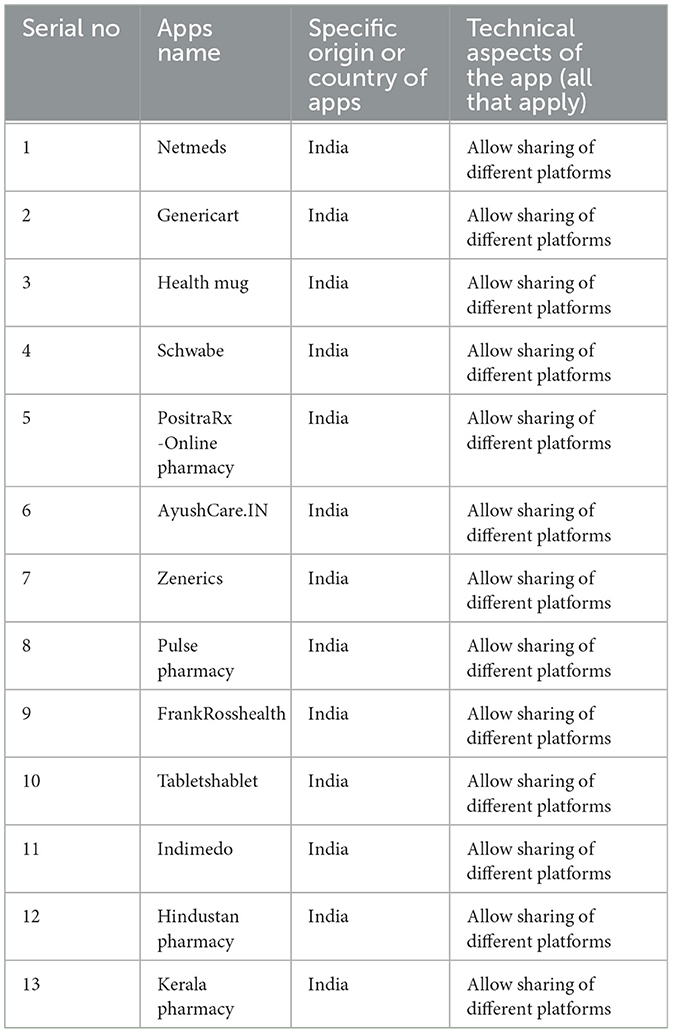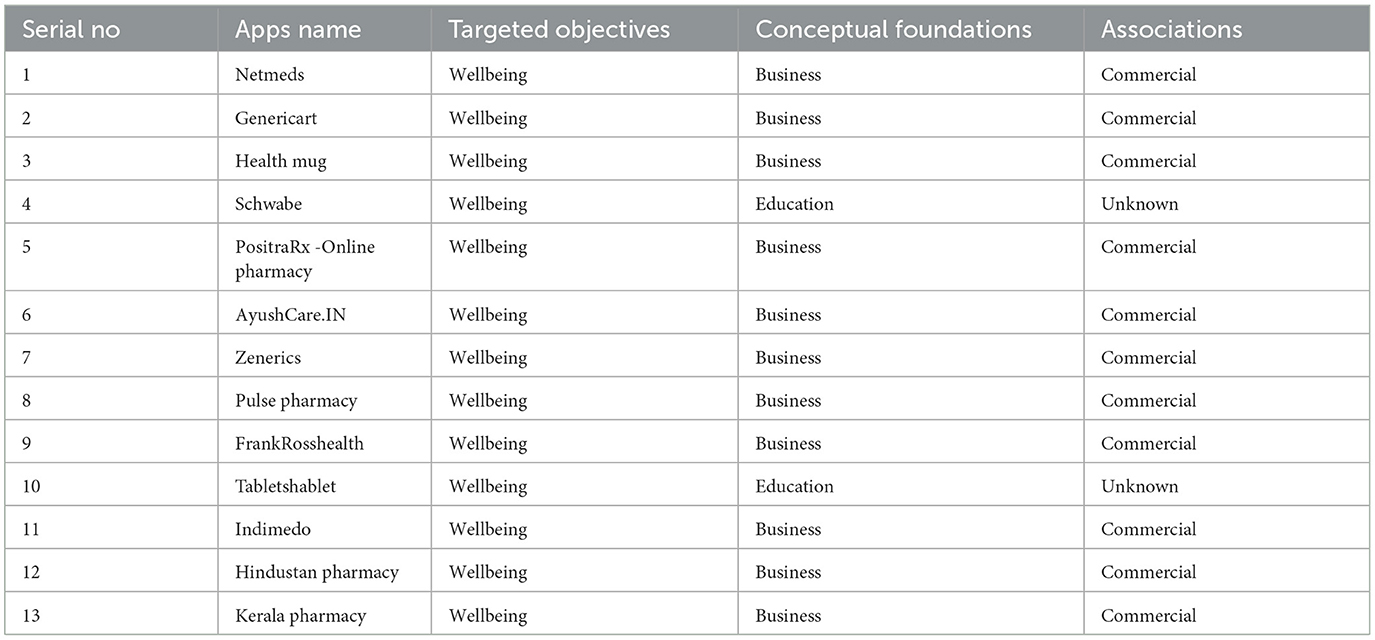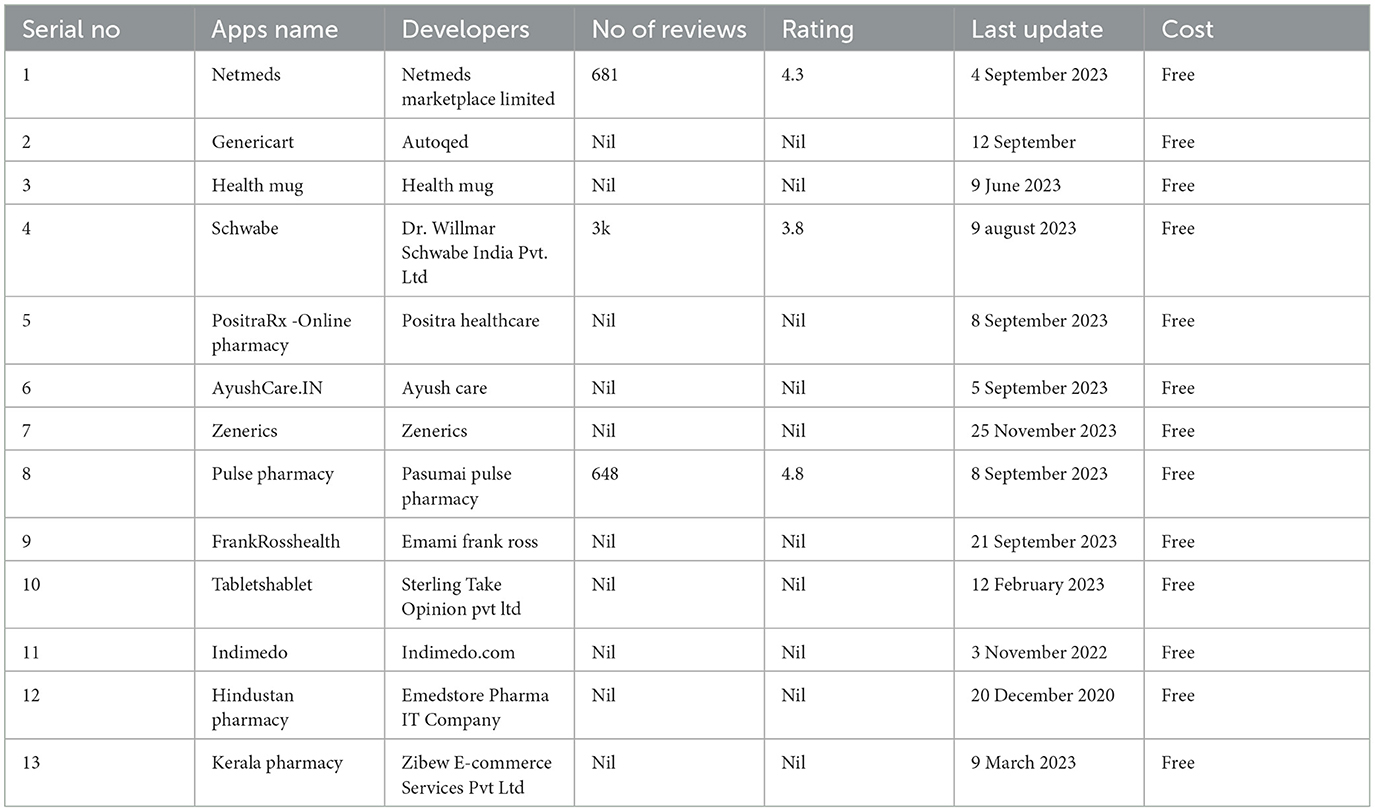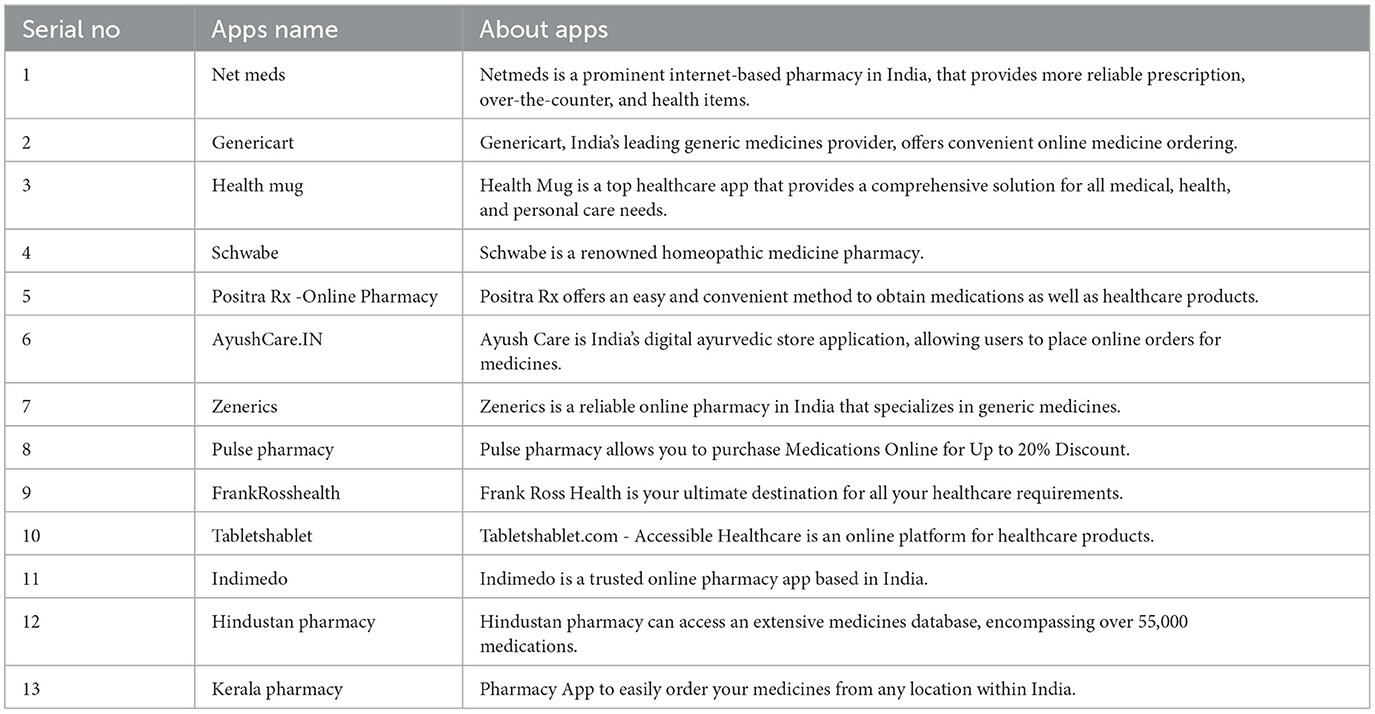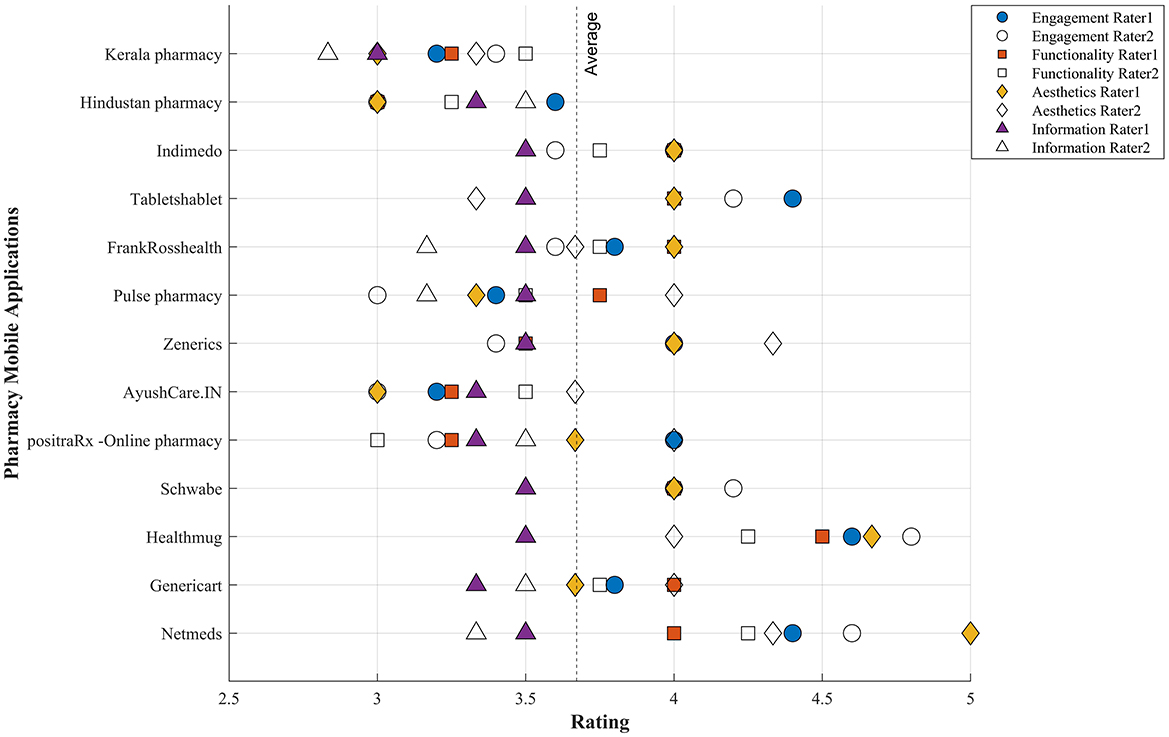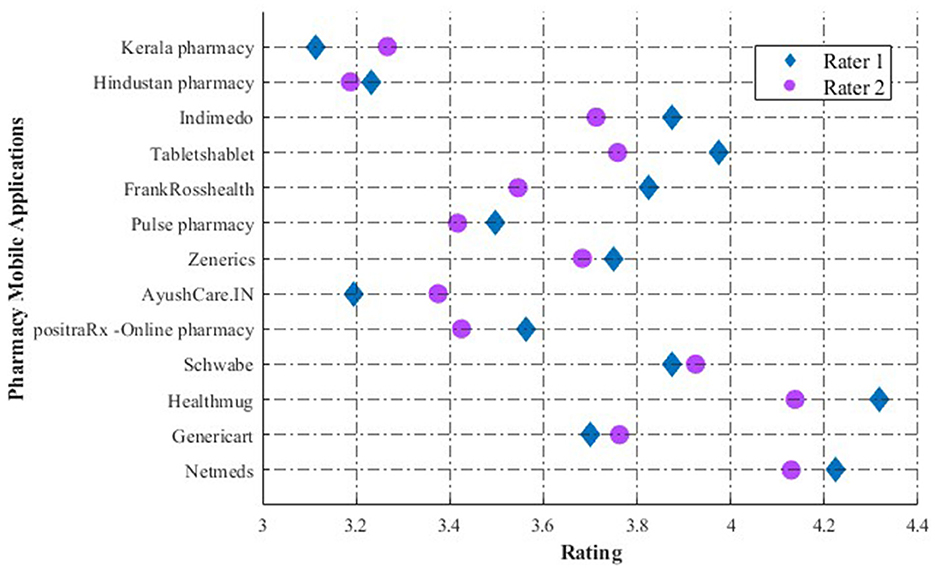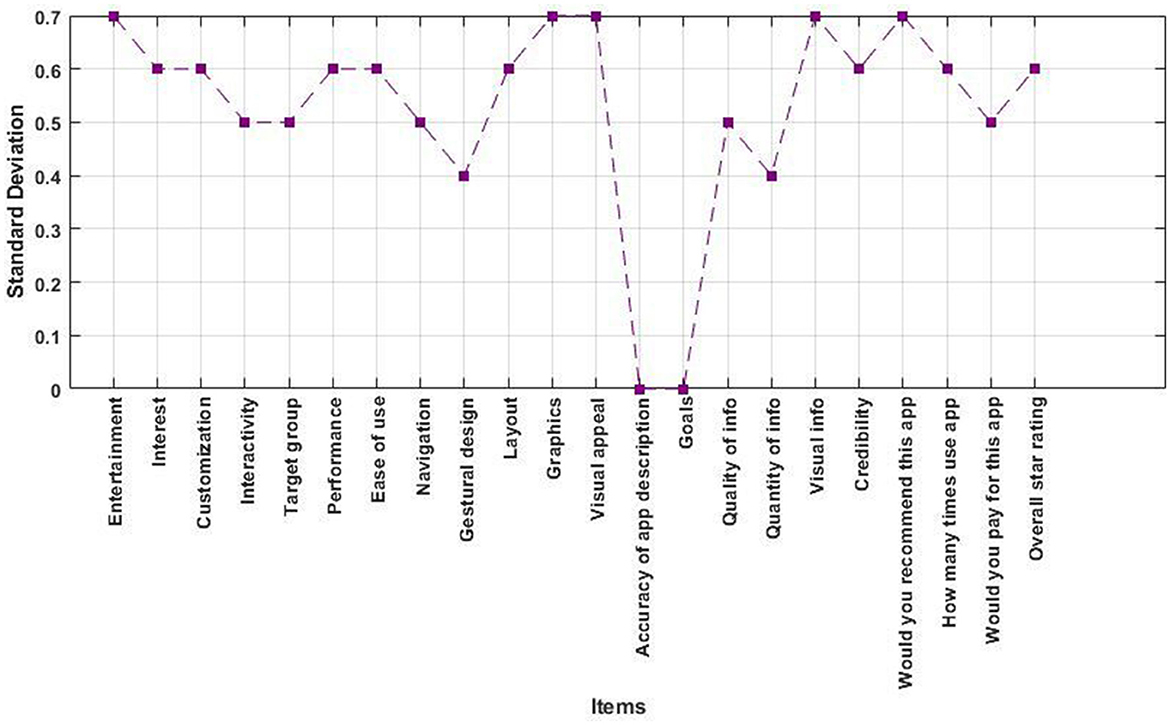- 1Faculty of Pharmacy, Jinnah University for Women, Karachi, Pakistan
- 2Department of Pharmacy Practice, Faculty of Pharmacy, Ziauddin University, Karachi, Pakistan
- 3Department of Pharmaceutical Chemistry, Karachi University, Karachi, Pakistan
- 4Department of Pharmacy Practice, Institute of Pharmaceutical Sciences, Jinnah Sindh Medical University, Karachi, Pakistan
- 5Department of Pharmaceutics, RAK Medical & Health Sciences University, Ras Al Khaimah, United Arab Emirates
- 6Department of Pharmacy Practice, School of Pharmacy, International Medical University (IMU), Kuala Lumpur, Malaysia
Introduction: Over the past few years, the technology powering mobile devices such as smartphones has made significant progress. Furthermore, the healthcare industry is always progressing and actively embracing the latest technological advancements to achieve the highest level of efficiency. With the rising prevalence of smartphones and internet connection, customers are benefiting from reduced prices, convenient home delivery, and effortless accessibility through online pharmacies. Internet-based pharmacies facilitate the internet-based transaction of health-related products, such as drugs, dietary supplements, and various other wellbeing products.
Objective of study: The study assessed digital pharmacy applications in India using the Mobile App Rating Scale (MARS) on Android and iOS devices, aiming to evaluate their quality.
Methods: An investigation examined the digital pharmacy applications in India that were accessible via the Android Market and App Store. The applications were assessed by two researchers using the MARS questionnaire, a tool that evaluates 23 variables categorized into five domains: Engagement, Functionality, Aesthetics, Information, and Subjective Quality. The grading system spanned from one to five for every category.
Results: A Google Play Store and App Store investigation revealed 40 online pharmacy apps in India, with 13 rejected. Seven were non-English language-related apps and seven were not downloaded. Thirteen were chosen and evaluated using the MARS Scale. The MARS demonstrated significant positive associations across its components, namely Engagement, Functionality, Aesthetics, and Information. Specifically, greater levels of user functionality were shown to be indicative of superior app aesthetics and engagement. The mean rating of the 13 apps fell between the range of 3.11 to 4.32 on a 5-point scale.
Conclusion: This is the first study to utilize the MARS scale to assess the efficacy of online pharmacy applications in India. This research enhanced the functionality and quality of various online pharmacy applications utilized in India.
1 Introduction
Online pharmacy is an internet-based platform or website that provides medicines, encompassing both prescription and non-prescription medications, along with a range of goods such as healthcare and cosmetic items (1). Many online pharmacies deliver orders with an approved prescription, others offer virtual consultations for prescribing and administering medications, whereas others supply meds without a doctor's order. Online pharmacy applications enable patients with rapid access to purchase medications from home, enhancing adherence via prescription refills and health information (2). In modern culture, people are increasingly dependent on the Internet for staying informed about health-related issues and for self-diagnosing and obtaining a wide variety of healthcare services and merchandise (3). The explosive rise of the World Wide Web, the emergence of digital health, a decrease in conventional doctor-patient interactions, customer comfort via purchasing goods online, the ease of mail-order commerce, and the development of separate selling are some of the factors that have contributed to the increase in customer appetite for electronic pharmacies (4, 5). The online pharmacy sector has seen significant growth in the past few years, with its total market value rising from $29.35 billion in 2014 to a projected $128 billion by 2023. The mentioned increase corresponds to a yearly rate of expansion of 17.7% (6).
Online advertising is now in its early stages of adoption in the Indian pharmaceutical business. Pharmaceutical businesses are using technology-based services to enhance patient education about their medical problems and to allow monitoring of their health. Furthermore, it is crucial to provide physicians with precise information on the patient's general health condition and any possible adverse effects of a certain chemical. Online tools can enable improved doctor-patient engagement based on particular health issues (7). Presently, there is a significant global presence of ~3,000 internet pharmacies. Indian customers are progressively demonstrating an escalating preference and shift toward online pharmacies, with this pattern gaining impetus over time. The expansion of the internet-based pharmaceutical industry in the Indian market may be ascribed to the increasing levels of internet awareness, heightened smartphone use, and the availability of efficient transaction options. The online pharmacy industry has lately become a significant player in the Indian e-commerce market, garnering interest from both government entities and business owners. The online pharmacy industry in India has achieved a value of over one billion dollars, thanks to the backing of 30 recently founded start-ups functioning in different sectors and regions of the nation (8).
In the year 2019, India had an estimated 850,000 pharmacy stores, accounting for 99% of the country's pharmaceuticals and medication sales. Conversely, internet-based pharmacies constituted a mere 1% of the overall medicine sales in India (9). In 2018, the number of internet customers in India reached ~560 million (56 crores), with a corresponding number of installations of 12.3 billion. This figure positions India as the second largest in the world, trailing only China. The cumulative duration of social media usage among individuals in India amounts to 17 h over 7 days, surpassing the average time spent by social media users in both China and the United States (10). India's pharmaceutical business holds the position of being the third-largest industry worldwide (1). Many individuals are inclined to adhere to prevailing patterns, and presently, the prevailing pattern is to engage in internet shopping due to its widespread convenience. Drugstore.com was established in 1999. Drugstore.com cannot be considered the pioneering online pharmacy, yet it is widely acknowledged as a reputable and reliable entity within the realm of online pharmaceutical services.
The Indian online pharmacy sector had significant market growth in 2015 (7, 11). In 2015, 11 online or internet pharmacy start-ups came together to establish the Indian Pharmacy Association (IPA). The organization comprises many members, namely MG, Net Meds, Bookmeds, mChemist, Medlife, Pharmacy, Medidart, Medstar, Zigy, Save on Medicals, and Save My Medicines (12).
The idea of an Internet pharmacy differs significantly from regular e-commerce trading due to the importance of adhering to distinct norms and regulations. There is a possibility of jeopardizing individuals' safety and wellbeing If health-related applications and devices are not submitted for comprehensive evaluations of their appropriateness and reliability. Multiple research projects have underscored the issue of unreliability in corroborating information within medical applications. The growing apprehension about the potential hazards associated with the use of medical applications has resulted in a heightened interest in monitoring the efficacy and reliability of these electronic devices. Over the previous 10 years, a team of researchers, under the leadership of Stoyan et al., devised the MARS (13). The MARS is a widely recognized and reliable assessment tool specifically developed for evaluating the functionalities of mobile health (mHealth) applications (13, 14). The technique consistently demonstrates strong dependability and provides a wide range of potential applications when used to comprehensively analyze the material of mobile applications. The MARS model consists of 23 distinct components that are categorized into multiple domains, such as involvement, utility, layout, data correctness, and subjective assessment (14–25).
2 Objective of study
The objective of our study was to perform a thorough assessment of digital pharmacy applications in India that were accessible on the Play Store on Google's Android devices and the App Store for iOS devices. To attain the above-indicated objective, a thorough assessment of these applications was carried out by implementing the MARS.
3 Methodology
3.1 Information on assets and investigation techniques
Two assessors, who specialized in pharmacy and have received education in the field of MARS, conducted a comprehensive search for digital pharmacy applications on the official marketplaces of the two leading operating systems, namely Android (Play Store) and iOS (App Store). To ensure the inclusiveness of the results, a highly popular search term or search string specifically “online pharmacy apps in India,” or Indian pharmacy, Indian medicine store, was employed to identify the relevant applications.
3.2 Parameters for acceptance
The sample selection criteria for the study were determined by a combination of inclusion and exclusion criteria. The inclusion criteria encompassed programs that were exclusively developed in India, available for download from both the Google Play Store and Apple iTunes Store, and relevant to the domain of online pharmacies. The study did not include biases linked to financial or premium apps and only apps in the English language were included in the analysis. The requirements for exclusion consisted of the omission of apps that required payment, apps that were not in the English language, apps that were not available for installation on Google Play and Apple iTunes stores, and any duplicates.
3.3 The features and attributes connected with applications
The compilation of the entire dataset entailed the incorporation of essential data derived by the applications. The data collection procedure involved gathering various properties of the applications, including the application's name, device compatibility (Android or iOS), cost, category (related to healthcare, wellness, and activity), date of the most recent update, primary language, number of reviews, rating, developer information, and download count.
3.4 The selection technique for online applications
The two independent evaluators conducted assessments on the titles and downloading apps from platforms. The applications that exhibited potential applicability were recorded in a database, while any ambiguities led to their exclusion. The applications that met the predetermined criteria were retained, while those that did not satisfy the specified conditions were excluded. When there is doubt over the appropriateness of an application, a third evaluator is involved.
3.5 Collecting and evaluating the integrity of information
The two evaluators who were pharmacists and received education on the MARS tool by watching a tutorial video available on the online site, YouTube (https://www.youtube.com/watch?v=25vBwJQIOcE). Following this, the evaluators proceeded to autonomously download, utilize, and evaluate the other software, also known as apps. To collect data, the investigators applied a comprehensive data collection form that included various pertinent details. These details included information about the application's designer, the device on which it was used, the current version of the application, the year of its latest release, associated costs, the number of downloaded files, star rating from consumers, the presence of a guarantee of security, privacy-related technical variables, medical device data, and the components evaluated through the Mobile App Rating Scale.
3.6 Investigative instrument
The evaluation of incorporated applications' usability utilized the Mobile App Rating Scale, a comprehensive tool comprising 23 criteria categorized into five groups. The engagement (A) assessment covers factors such as enjoyment, user interest, personalization, interaction (including alerts, messages, signals, and comments), and suitability for the target demographic.
The functionality (B) of the application includes 4 key aspects: operational efficiency, ease of utilization, directions, conceptual flow, and gestures layout. The aesthetics section (C) assesses graphic layout elements, visual attractiveness, chromatic palette, and aesthetic coherence. Another part Information (D) examines the existence of quality data, including textual content, comments, evaluations, and citations from reliable sources.
The subjective quality section (E) consisting of four items, evaluates the consumer's level of enthusiasm for the application on a rating scale from one (indicating inadequacy) to five (representing excellence). The composite app grade was determined by computing the average score across parts A, B, C, and D. Application performance results, a subjective measure, was derived separately by calculating the mean value of the subsection. Subsection (F) perceived impact included six app-specific questions assessing the perceived impact of the application on users' understanding, attitudes, intentions for change, and the likelihood of successful behavior modification related to the targeted wellness behavior.
To enhance the objectivity of the MARS scale in evaluating application excellence, the subjective aspect of the quality part was excluded from the overall average app performance grade calculation. Moreover, the strong association demonstrated in prior research between the MARS sum score and individual star ratings suggests its effectiveness in reflecting overall perceived excellence (13).
3.7 Compiling and evaluating data
Each reviewer autonomously assessed all elements within the MARS for each of the applications. The numerical evaluations provided by both evaluators were used to calculate the average rating for each item within each app. Subsequently, the average scores were aggregated to analyze the overall mean scores for each category and section of the MARS across all applications. Mean scores and standard deviations were then computed for each area, applying the same methodology to derive the overall score and its corresponding standard deviation for each application.
3.8 Statistical analysis
The data underwent analysis using SPSS version 27. The examination of every facet of MARS involved utilizing the mean value, following the recommendation of its creators. Mean, standard deviation, and Pearson correlation analyses were employed for all dimensions of MARS. To evaluate the internal reliability of the MARS quality subscales, Cronbach's alpha was applied. This statistical metric gauges the degree of associations among components assessing the same underlying construct and their ability to yield comparable results. The intraclass correlation coefficient (ICC) was utilized to assess the internal consistency of the MARS subscales.
4 Results
We initiated a preliminary search on both the Google Play Store and the App Store to identify 40 online pharmacy applications available in India, as illustrated in Figure 1. Thirteen apps were excluded from the study as they did not meet the inclusion criteria. Additionally, seven applications were omitted from the analysis because they were based on non-English languages. Furthermore, seven applications were not downloaded for this study. The final selection for inclusion in the study, as depicted in Figure 1, comprised a total of 13 applications.
4.1 Attributes of the applications
Mobile applications have become an essential aspect of contemporary life, particularly within the healthcare and pharmacy sectors. These apps provide convenient access to a diverse range of healthcare and pharmaceutical products and services. The tables below offer a comprehensive analysis of healthcare and pharmacy-related applications in India, covering technical features, creator details, customer reviews, pricing, version specifications, affiliations, and other relevant information. Table 1 provides a detailed overview of the technological features associated with various pharmaceutical applications. Each app is uniquely identified by a serial number, and the table outlines its distinct technological capabilities, such as content distribution across platforms and secure login functionalities. This resource is valuable for users and developers, aiding in understanding the functionalities and potentials of these applications.
Table 2 offers a concise summary of the primary focus areas, strategies, and affiliations of these apps. The analysis indicates that these applications aim to improve individual wellbeing while adopting a business-oriented approach through commercial partnerships. This information helps users comprehend the goals and target market of these applications. Table 3 provides a comprehensive analysis of pharmacy application manufacturers, including essential details such as evaluations, user feedback, the latest update date, and the app's pricing model (free or paid). This chart serves as a crucial tool for users to assess the reliability of these programs based on the creators' reputation and user feedback. Table 4 examines various versions of pharmaceutical software, including download statistics, release times, and compatible operating systems. This data is valuable for users seeking compatibility with their devices and the latest application versions to stay updated.

Table 4. Application information encompassing version updates, download statistics, platform compatibility, and associated costs.
Table 5 offers concise and informative descriptions of pharmacy applications, providing users with a summary of each app's features and unique value proposition. This feature is especially beneficial for individuals searching for an application that aligns with their healthcare and pharmaceutical needs. The average mean score of all applications by two raters using the MARS scale is depicted in Figure 2. The mean score of each of the dimensions of the MARS scale by two raters is illustrated in Figure 3. Table 6 displays the internal consistency and interrater reliability metrics for the MARS items and subscale scores. It also contains item-total correlations that have been rectified and descriptive data for individual items that come from independent assessments of 13 Indian online drugstore applications.
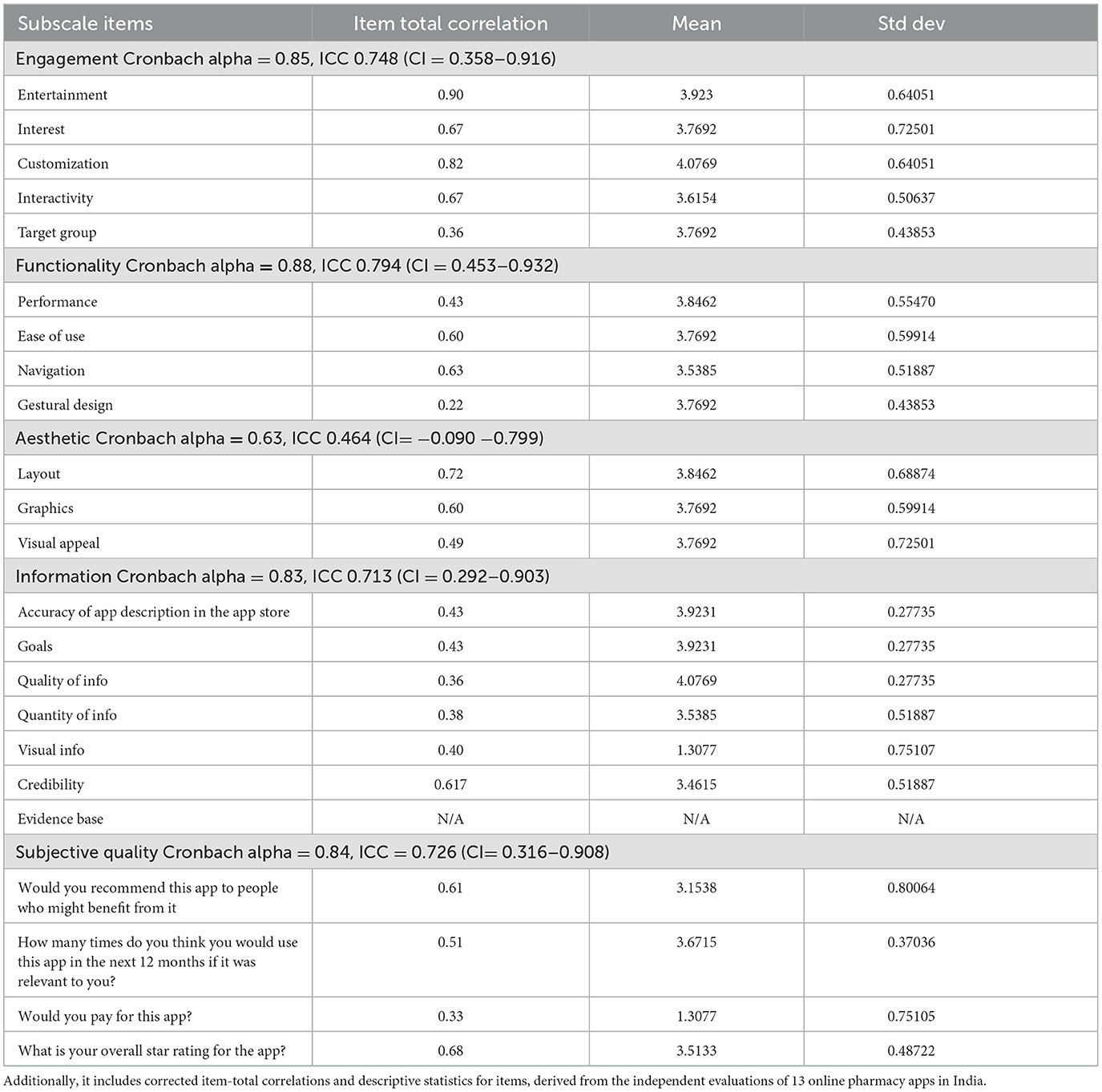
Table 6. The interrater reliability and internal consistency metrics for both the MARS items and subscale scores.
The survey findings provide a thorough evaluation of many aspects of user engagement and satisfaction with the app. The Engagement subscale, which has a great Cronbach alpha reliability of 0.85 and a considerable ICC of 0.748 (CI = 0.358–0.916), explores various dimensions like Entertainment, Interest, Customization, Interactivity, and Target Group. The mean ratings for Entertainment and Customization were notably high, with values of (3.923 and 4.0769), respectively. This indicates that users considered these features to be very engaging. On the other hand, the mean score for Target Group was lower at 3.7692, showing that there is space for development in targeting certain user groups. The standard deviation of the engagement dimension ranges between 0.43 and 0.72 demonstrated in Figure 4.
The Functionality subscale assesses Performance, Ease of Use, Navigation, and Gestural Design. It has a high level of internal consistency with a Cronbach alpha reliability of 0.88 and a strong test-retest reliability with an intraclass correlation coefficient (ICC) of 0.794 (CI = 0.453–0.932). While Performance and Ease of Use obtained mean ratings of 3.8462 and 3.7692 respectively, Navigation had a slightly lower mean of 3.5385, indicating possible usability difficulties. Gestural Design had the lowest mean of 3.7692, showing a need for improvement. The standard deviation of the functionality dimension ranges between 0.43 and 0.55 demonstrated in Figure 4.
The Aesthetic subscale examines Layout, Graphics, and Visual Appeal. It has a Cronbach alpha reliability of 0.63 and an ICC of 0.464 (CI = −0.090–0.799). The Layout category had the highest score, with a mean of 3.8462, followed by Graphics and Visual Appeal. This suggests an overall pleasant aesthetic experience. The standard deviation of aesthetic dimension ranges between 0.68 and 0.72 demonstrated in Figure 4.
The Information subscale evaluates many aspects such as the Accuracy of App Description, Goals, Quality of Info, Quantity of Info, Visual Info, Credibility, and Evidence Base (unavailable). It has a high Cronbach alpha reliability of 0.83 and an ICC of 0.713 (CI = 0.292–0.903). The measure of credibility was notably strong, with a mean value of 3.4615. On the other hand, the mean value for Visual Info was much lower at 1.3077, suggesting possible concerns with the presentation of visual information. The standard deviation of the information dimension varies from 0.27 to 0.75 shown in Figure 4.
The Subjective Quality subscale, with a Cronbach alpha reliability of 0.84 and an ICC of 0.726 (CI = 0.316–0.908), investigates users' subjective evaluations. Users showed a clear inclination to suggest the app (mean of 3.1538). However, their readiness to pay for the app resulted in a lower mean of 1.3077. The standard deviation of the subjective quality dimension varies from 0.37 to 0.80 shown in Figure 4.
The item-total correlation for the engagement dimension subsection was excellent (0.90) in the entertainment category, while it was satisfactory (0.70) in the target group. The performance of the functionality portion has a robust correlation (0.43), although the correlation with gestural design is minimal (0.22). The aesthetics portion arrangement correlates (0.72), whilst visual appeal shows a correlation of (0.49). The accuracy of the information part of the app exhibits a significant relationship of (0.43), while the quality of the information has a modest association of (0.36). The overall rating score of MARS of all applications of online pharmacies of India demonstrated good reliability by employing the ICC (0.464–0.794) and the total scores of apps showed great consistency by using Cronbach alpha (0.88). The average star rating of 3.5133 indicates that users typically have a positive impression. The comprehensive analysis provides developers with useful insights, identifying strong points and possible areas for improvement in the app's engagement, functionality, aesthetics, information provided, and overall subjective quality.
5 Discussion
This is the first study to assess the quality of Indian online applications. The objective of the research was to assess the quality of online pharmacy applications in India that are accessible through the Google Play Store and App Store, employing the Mars Scale. The Mars scale is an innovative, multidimensional (engagement, functionality, aesthetic, information, and subjective) evaluation framework designed specifically for mobile health applications (13). A total of forty applications were initially selected for this study from both app stores; however, following the application of inclusion and exclusion criteria, only 13 applications met the inclusion criteria. All applications were selected at random and were written in English. Many apps have high star ratings, usually ranging from 4.3 to 4.8 out of 5, which suggests that users are generally satisfied, according to an analysis of the app market. But, since these ratings may not always correctly reflect app quality, it's important to approach them cautiously. To gain more insight, this study used the MARS. An overall respectable level was indicated by the 3.11 out of 5 MARS score that the chosen applications combined to receive. It is noteworthy, however, that significant variation was found in several domains, most notably aesthetics, where scores varied from 3.0 to 5.0. This unevenness suggests that there is a wide range of app quality available right now, with certain examples pointing to the existence of lower-quality options.
The functionality subscale, which assessed the ease of use, performance, navigation, and gesture capabilities of applications, achieved the highest ICC value. Conversely, the aesthetic subscale, which evaluated the visual information, layout, and graphics of applications, received the lowest ICC value. As cited in previous research, the subjective component was omitted from the final Mars score. Our research demonstrated a lower ICC value in comparison to the previous study (26).
The majority of the applications were readily downloadable from the App Store and Android Market. Numerous applications exhibited authentication and security functionality issues. We limited our selection for this study to applications that offered simple authentication procedures, requiring neither a login name nor a mobile number. The information section of the majority of applications comprises fundamental medicine-related details, such as the dosage form, dose, indications, adverse effects, warnings, brand names, and cost of the medication. Traditionally, physicians were responsible for providing patients with information about their illness, its development, and potential treatments. However, with the rise of the internet, the dynamic between doctors and patients has shifted. Increasingly, individuals are turning to the Internet for self-diagnosis and treatment options. This trend toward self-medication is particularly significant in countries like India, where access to healthcare services may be limited for many people (27). In the 1990s, internet usage accounted for just 1% of the global population, but today, that figure has skyrocketed to 90% worldwide (28). By the end of 2019, India's internet users are projected to reach 627 million, representing 40% of the total population, with a significant portion utilizing the internet for self-medication and accessing health-related information. Self-medication is a global phenomenon, with prevalence ranging from 53% to 75% across different countries. Over the last decade, the prevalence of self-medication in India has surged from 31% to 71% (29).
Online pharmacy apps offer a range of services beyond just dispensing medications, including prescription refills and access to comprehensive drug information. Despite the central role pharmacies play in healthcare, there is a notable absence of studies exploring this aspect. Our study addresses this gap by examining the fundamental involvement, functions, layout, and information provided by pharmacy services within these apps.
5.1 Limitation
This research endeavor is not without its inherent limitations. The extent of our research was primarily restricted to a predetermined geographical area, specifically India, and specifically concentrated on applications that are available in the English language. The narrow scope used in this analysis may have unintentionally overlooked a broader global perspective, thus potentially disregarding valuable information obtained from a wider array of applications. Furthermore, our analysis is limited by its exclusive emphasis on free apps. The decision's omission of commercial apps failed to acknowledge the possible valuable perspectives and data they may provide. We must recognize that our technique mostly focused on app stores and did not include a thorough examination of existing literature. Therefore, our analysis may not have thoroughly examined the whole spectrum of available material and academic research on this specific subject. Another limitation of our study was eradicating the user's perspective and based on the MARS scale objectives However, this constraint may be addressed in a future investigation. Users' perspective, which may have resulted in a more acceptable assessment of the application.
5.2 Future recommendation
To enhance the reliability of online pharmacy applications in India, it is recommended to implement stricter regulations and guidelines, conduct regular audits to evaluate the content of these applications, strengthen data security measures, and provide standardized and evidence-based medical information. Further inquiries may concentrate on examining client views and opinions on these apps, with a specific emphasis on the dynamics of user-platform interaction and the building of trust. It is also recommended that further research be done using multiple mobile apps, patient population, and limited resources.
5.3 Ethics approval
Ethical approval was obtained for this study from Jinnah University for Women with reference number JUW/IERB/PHARM-ERA-004/2023.
6 Conclusion
The MARS which was used to evaluate mobile pharmacy applications in India, has yielded important insights into the dependability and efficiency of these apps. The study's findings highlight how crucial it is to make sure that online pharmacy platforms are reliable and legitimate. This study boosts the confidence of the consumer of online pharmacy applications as well as promotes the growth and quality of online pharmacy applications.
Data availability statement
The raw data supporting the conclusions of this article will be made available by the authors, without undue reservation.
Ethics statement
Ethical approval was obtained for this study from Jinnah University for Women with reference number JUW/IERB/PHARMERA004/2023.
Author contributions
AS: Conceptualization, Investigation, Methodology, Software, Validation, Writing – original draft. SN: Investigation, Project administration, Supervision, Writing – review & editing. HR: Data curation, Investigation, Methodology, Visualization, Writing – review & editing. SU: Formal analysis, Investigation, Writing – review & editing. SJ: Investigation, Writing – review & editing.
Funding
The author(s) declare that no financial support was received for the research, authorship, and/or publication of this article.
Acknowledgments
We would like to extend my appreciation to Jinnah University for Women for providing the necessary resources.
Conflict of interest
The authors declare that the research was conducted in the absence of any commercial or financial relationships that could be construed as a potential conflict of interest.
Publisher's note
All claims expressed in this article are solely those of the authors and do not necessarily represent those of their affiliated organizations, or those of the publisher, the editors and the reviewers. Any product that may be evaluated in this article, or claim that may be made by its manufacturer, is not guaranteed or endorsed by the publisher.
Abbreviations
MARS, Mobile Application Rating Scale; Apps, Applications; ICC, Intraclass Correlation Coefficient; CI, Confidence Interval; IPA, Indian Pharmacy Association.
References
1. Chaudhry PE. The challenge of curtailing the escalation of counterfeit pharmaceuticals. In: Handbook of Research on Counterfeiting and Illicit Trade, 2017. Northampton MA: Edward Elgar Publishing. p. 157-192. doi: 10.4337/9781785366451.00017
2. Radatz C. Internet Pharmacies, Wisconson Briefs, Brief 04-5, March 2004. Madison, WI: Wisconsin Legislative Reference Bureau (2005).
3. Seckin G. Patients as information managers: the Internet for successful self-health care & illness management. Open Longevity Sci. (2010) 4:1.
4. Fung CH Woo HE and Asch SM. Controversies and legal issues of prescribing and dispensing medications using the Internet. In: Mayo Clinic Proceedings. London: Elsevier. (2004).
5. Yadav AK, Pichholiya M, Sheth H, Gupta S, Choudhary S. Knowledge and attitude toward e-pharmacy among the physicians of south rajasthan, india: a pilot survey. Asian J Pharm Clin Res. (2020) 13:157–60. doi: 10.22159/ajpcr.2020.v13i9.38862
6. Market OD. Global Industry Analysis, Size, Share, Growth, Trends and Forecast, 2013-2019. Albany, NY: Transparency Market Research. (2014).
7. Dutta D, Bhattacharjee B. Consumer preference and buying pattern of medicines through e-pharmacy during COVID-19 pandemic in Silchar, Assam. Curr Trends Pharmaceut Res. (2021) 8:192–211.
9. Singh H, Majumdar A, Malviya N. E-Pharmacy impacts on society and pharma sector in economical pandemic situation: a review. J Drug Delivery Therapeut. (2020) 10:335–340. doi: 10.22270/jddt.v10i3-s.4122
10. Priyadarshani P, Purwar R, Pipal VR, Mall RP. Patient satisfaction with telemedicine services in obstetrics and gynecology during the COVID-19 pandemic. J South Asian Feder Obstetr Gynaecol. (2021) 13:382–6. doi: 10.5005/jp-journals-10006-1974
11. Roshini A, Pavithra G. e-Pharmacy-A boon or bane. Int J Pharmaceut Res. (2021) 13:2. doi: 10.31838/ijpr/2021.13.02.246
12. Dhale S, Singh DK. e-Pharmacy in India: an exponential growth opportunity. Int J. (2022). 10:11.
13. Stoyanov SR, Hides L, Kavanagh DJ, Zelenko O, Tjondronegoro D, Mani M. Mobile app rating scale: a new tool for assessing the quality of health mobile apps. JMIR mHealth and uHealth. (2015) 3:e3422. doi: 10.2196/mhealth.3422
14. Mani M, Kavanagh DJ, Hides L, Stoyanov SR. Review and evaluation of mindfulness-based iPhone apps. JMIR mHealth and uHealth. (2015) 3:e4328. doi: 10.2196/mhealth.4328
15. McKay FH, Cheng C, Wright A, Shill J, Stephens H, Uccellini M. Evaluating mobile phone applications for health behaviour change: a systematic review. J Telemed Telecare. (2018) 24:22–30. doi: 10.1177/1357633X16673538
16. Salazar A, de Sola H, Failde I, Moral-Munoz JA. Measuring the quality of mobile apps for the management of pain: systematic search and evaluation using the mobile app rating scale. JMIRmHealth uHealth. (2018) 6:e10718. doi: 10.2196/10718
17. Kalhori SRN, Hemmat M, Noori T, Heydarian S, Katigari MR. Quality evaluation of English mobile applications for gestational diabetes: app review using Mobile Application Rating Scale (MARS). Current Diab Rev. (2021) 17:161–8. doi: 10.2174/1573399816666200703181438
18. Davalbhakta S, Advani S, Kumar A, Agarwal A. Bhoyar R, Fedirka D, et al. A systematic review of smartphone applications available for corona virus disease 2019 (COVID19) and the assessment of their quality using the mobile application rating scale (MARS). J Med Syst. (2020) 44:1–15. doi: 10.1007/s10916-020-01633-3
19. Romero RL, Kates F, Hart M, Ojeda A, Meirom I, Hardy S. Quality of deaf and hard-of-hearing mobile apps: evaluation using the Mobile App Rating Scale (MARS) with additional criteria from a content expert. JMIR mHealth and uHealth. (2019) 7:e14198. doi: 10.2196/14198
20. Knitza J, Tascilar K, Messner E-M, Meyer M, Vossen D, Pulla A, et al. German mobile apps in rheumatology: review and analysis using the Mobile Application Rating Scale (MARS). JMIR mHealth and uHealth. (2019) 7:e14991. doi: 10.2196/14991
21. Bardus M, van Beurden SB, Smith JR, Abraham C. A review and content analysis of engagement, functionality, aesthetics, information quality, and change techniques in the most popular commercial apps for weight management. Int J Behav Nutr Phys Act. (2016) 13:1–9. doi: 10.1186/s12966-016-0359-9
22. Steeb T, Wessely A, French LE, Heppt MV, Berking C. Skin cancer smartphone applications for German-speaking patients: review and content analysis using the Mobile App Rating Scale. Acta Dermato-Venereologica. (2019) 99:1043–4. doi: 10.2340/00015555-3240
23. Sharif MO, Alkadhimi A. Patient focused oral hygiene apps: an assessment of quality (using MARS) and knowledge content. Br Dental J. (2019) 227:383–6. doi: 10.1038/s41415-019-0665-0
24. Choi YK, Demiris G, Lin S-Y, Iribarren SJ, Landis CA, Thompson HJ, et al. Smartphone applications to support sleep self-management: review and evaluation. J Clinical Sleep Med. (2018) 14:1783–90. doi: 10.5664/jcsm.7396
25. Kim BY, Sharafoddini A, Tran N, Wen EY, Lee J. Consumer mobile apps for potential drug-drug interaction check: systematic review and content analysis using the mobile app rating scale (MARS). JMIR mHealth and uHealth. (2018) 6:e8613. doi: 10.2196/mhealth.8613
26. Hides L, Hermens DF, Kavanagh M, Stoyanov L, Redman DJ, Burns JB. The mobile application rating scale (MARS): a new tool for assessing the quality of health apps. Presented at: Young and Well Cooperative Research Centre (CRC) Connect National Conference. Melbourne, VIC: Young and Well Cooperative Research Centre (2014).
27. Greenhalgh T. Drug prescription and self-medication in India: an exploratory survey. Soc Sci Med. (1987) 25:307–18. doi: 10.1016/0277-9536(87)90233-4
28. Hilbert M, López P. The world's technological capacity to store, communicate, compute information. Science. (2011) 332:60–5. doi: 10.1126/science.1200970
Keywords: India, MARS, online, pharmacies, mobile applications
Citation: Sattar A, Naveed S, Rehman H, Usman S and Jamshed S (2024) Assessment of online pharmacy applications in India by employing the mobile application rating scale. Front. Public Health 12:1486990. doi: 10.3389/fpubh.2024.1486990
Received: 27 August 2024; Accepted: 21 October 2024;
Published: 13 November 2024.
Edited by:
Uffe Kock Wiil, University of Southern Denmark, DenmarkReviewed by:
Paul Kwon, US Army PEO STRI, United StatesBeenish Chaudhry, University of Louisiana at Lafayette, United States
Copyright © 2024 Sattar, Naveed, Rehman, Usman and Jamshed. This is an open-access article distributed under the terms of the Creative Commons Attribution License (CC BY). The use, distribution or reproduction in other forums is permitted, provided the original author(s) and the copyright owner(s) are credited and that the original publication in this journal is cited, in accordance with accepted academic practice. No use, distribution or reproduction is permitted which does not comply with these terms.
*Correspondence: Anum Sattar, YW51bS5zYXR0YXJAenUuZWR1LnBr; YW51bXNhdHRhcjIwMThAZ21haWwuY29t
 Anum Sattar
Anum Sattar Safila Naveed3
Safila Naveed3 Shazia Jamshed
Shazia Jamshed